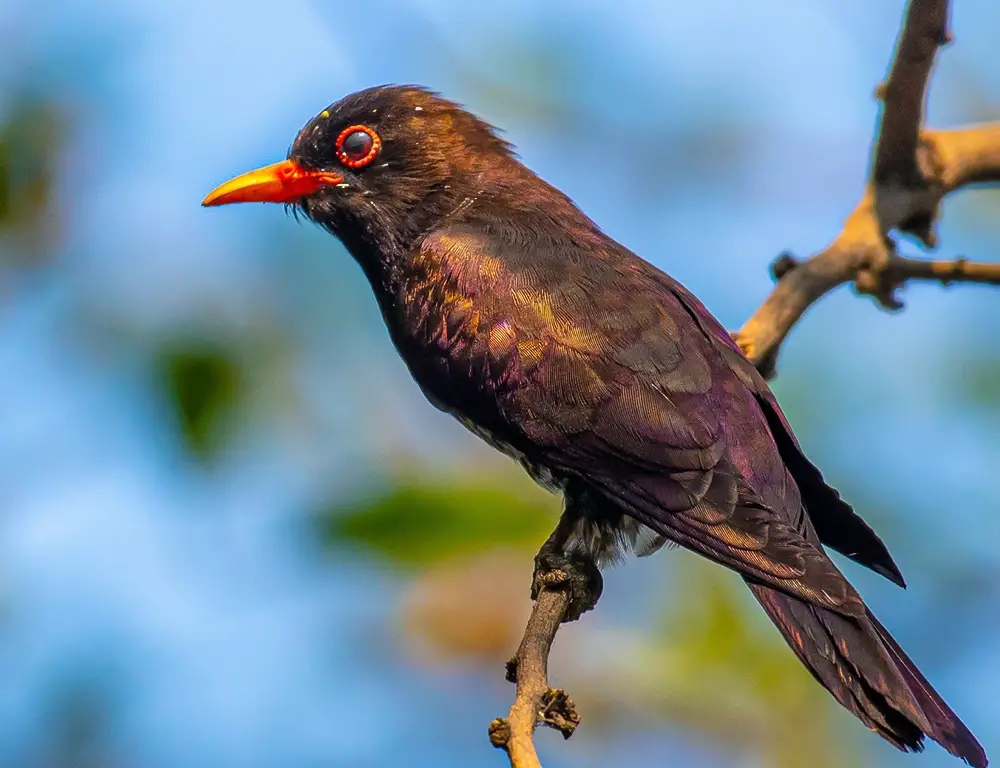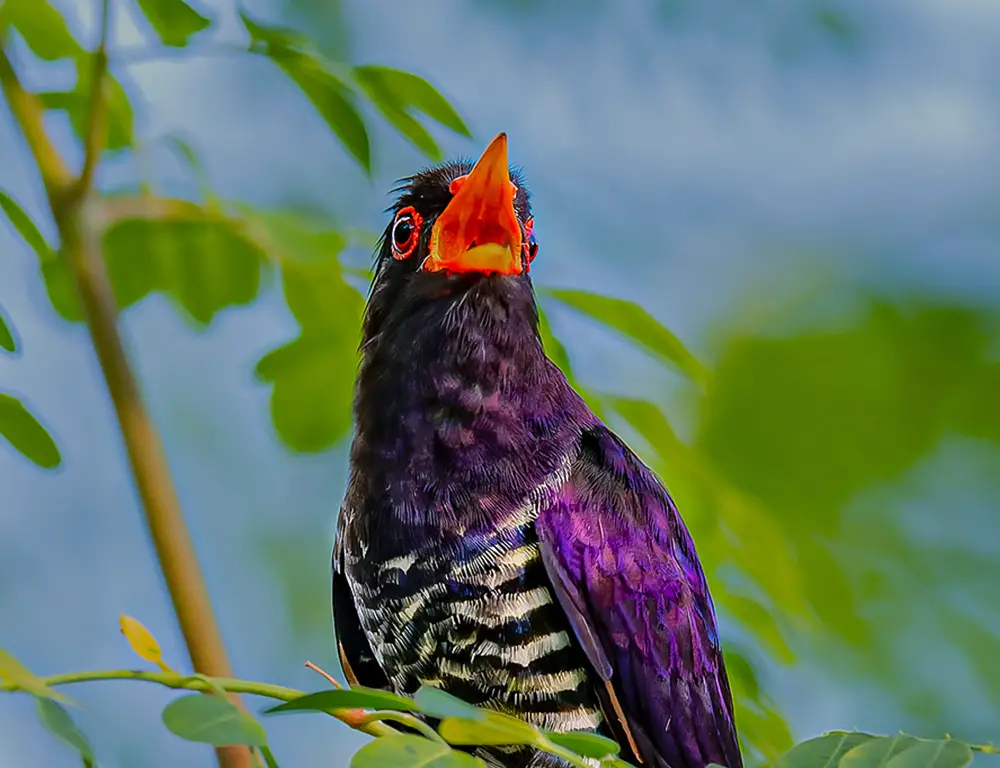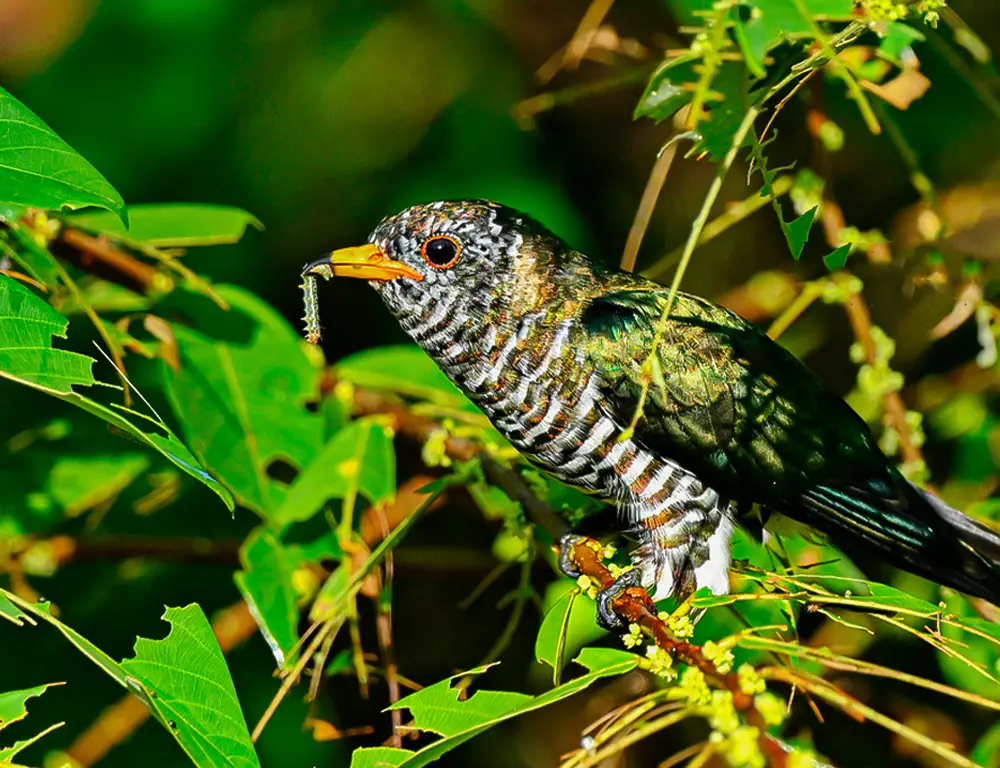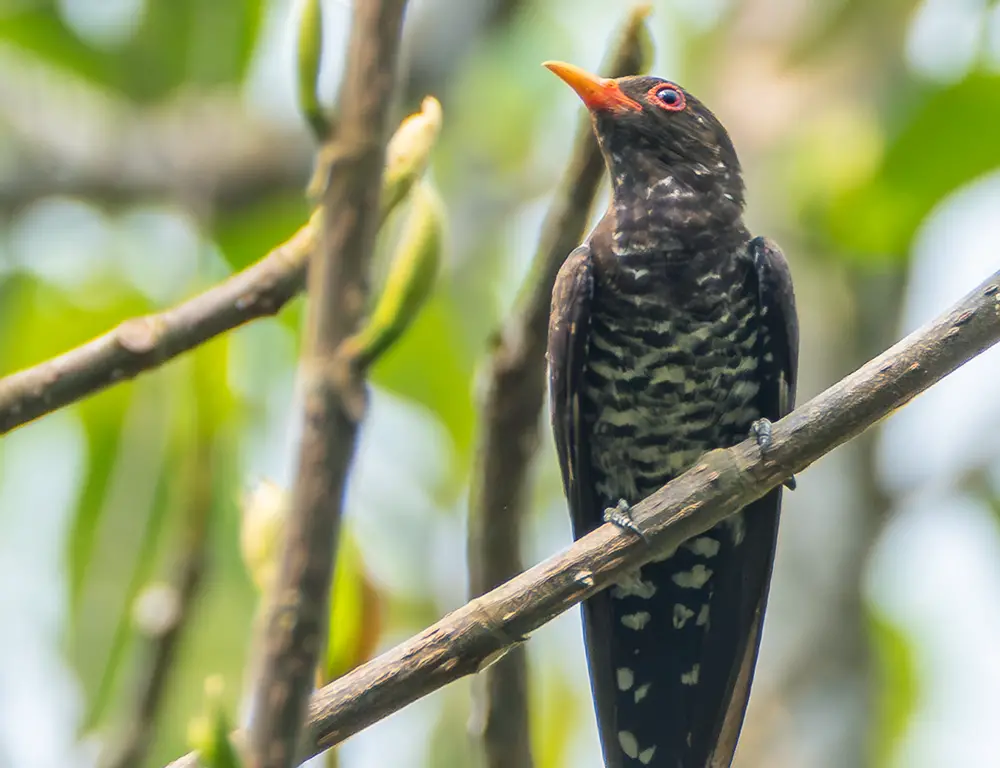With its captivating plumage and distinctive habits, the Violet Cuckoo is a fascinating subject of study in the avian world.
Native to Southeast Asia, this bird boasts iridescent violet or purple feathers strikingly contrasting with its stark white belly, creating a visually stunning appearance.
Beyond its aesthetics, the Violet Cuckoo is renowned for its echoing calls that resonate throughout its habitat.
However, its intriguing breeding behavior truly sets it apart: like most cuckoos, it lays its eggs in the nests of other bird species.
This blend of beauty and behavioral uniqueness piques curiosity, compelling further exploration into the secrets of the Violet Cuckoo.

Physical Characteristics of the Violet Cuckoo
The Violet Cuckoo (Chrysococcyx xanthorhynchus) is a visually striking bird with distinctive physical characteristics that set it apart in the avian world.
Here’s an overview of its physical attributes:
Plumage
The adult male Violet Cuckoo exhibits a captivating iridescent violet or purple plumage, particularly prominent on its head, back, and wings. This vibrant coloration is complemented by a shining green crown that adds to its allure.
Its underside, including the belly and chest, contrasts with a pale greyish-white color, creating a striking visual contrast.
The male’s long tail feathers are adorned with white spots, enhancing its elegance. Female Violet Cuckoos, while less flashy, display greenish-bronze plumage with white bars across their underparts.
Size and Shape
Violet Cuckoos are medium-sized birds, with adults typically measuring around 28-30 centimeters (11-12 inches) in length. Their slender bodies, graceful proportions, and long tails contribute to their agile and elegant appearance.
Their broad wings facilitate swift flight through the forest canopy, where they spend much of their time foraging for insects.
Weight
The average weight of a Violet Cuckoo ranges from 65 to 70 grams (approximately 2.3 to 2.5 ounces). This weight may vary slightly depending on age, sex, and individual variation within the species.
Bill
These birds possess short, stout bills, well-suited for their insectivorous diet. The bill is used to capture and consume a variety of small prey, including caterpillars and other insects found in their arboreal habitat.
Tail
One distinctive feature of the Violet Cuckoo is its long tail, which adds elegance. The tail feathers are often tipped with white spots, enhancing their visual appeal.
Voice

While physical, the Violet Cuckoo’s voice is another notable characteristic. Males are known for their distinctive calls, which echo through the forest canopy during the breeding season. These calls play a crucial role in courtship and territorial communication.
Sexual Dimorphism
As is common among many bird species, there is sexual dimorphism in Violet Cuckoos, with males exhibiting more vibrant plumage than females. This difference in appearance helps distinguish between the sexes, particularly during the breeding season.
Habitat and Distribution of the Violet Cuckoo
The Violet Cuckoo (Chrysococcyx xanthorhynchus) exhibits a diverse habitat preference and broad distribution across Southeast Asia.
Here’s an overview of its habitat and distribution:
Habitat
Violet Cuckoos inhabit various environments, ranging from dense forests to well-wooded gardens.
They show a particular affinity for primary and secondary rainforests, where they find ample food sources and suitable nesting sites.
These birds are primarily arboreal, spending much of their time in tree canopies, where they forage for insects, especially caterpillars. While they prefer forested areas, they have also been observed in plantations and suburban gardens with sufficient tree cover.
Distribution
The Violet Cuckoo has a broad geographical distribution across Southeast Asia, including countries such as India, China, Indonesia, and Papua New Guinea.
Here’s a breakdown of its distribution in some key regions:
- India: In India, Violet Cuckoos are predominantly found in the northeastern regions, where dense forests provide suitable habitat.
- China: Southern provinces like Yunnan are known to host populations of these birds, where they inhabit forested areas.
- Indonesia & Papua New Guinea: These islands provide ideal habitats for Violet Cuckoos due to their extensive tree cover, and the birds can be found in various forested regions.
Geographical Spread
The Violet Cuckoo’s distribution spans across the Asian continent and Australasia. It occupies many habitats within these regions, from tropical rainforests to subtropical forests and wooded areas.
Behavior and Diet of the Violet Cuckoo

The behavior and diet of the Violet Cuckoo (Chrysococcyx xanthorhynchus) are fascinating aspects of its natural history, showcasing its unique adaptations and ecological role.
Here’s an overview of its behavior and diet:
Breeding Behavior
During the breeding season, male Violet Cuckoos use courtship displays to attract females. Their plumage becomes more vibrant, with iridescent violet-blue hues, enhancing their attractiveness to potential mates.
Unlike many other bird species, Violet Cuckoos are brood parasites, meaning they do not build their own nests. Instead, they lay their eggs in the nests of different bird species, particularly those of spiderhunters (species within the genus Arachnothera).
This behavior takes advantage of the parental instincts of the host birds, allowing Violet Cuckoos to save energy on nest building and chick rearing.
Feeding Habits
Violet Cuckoos are primarily insectivorous, with caterpillars forming a significant portion of their diet. They prefer hairy caterpillars, which many other bird species avoid due to their stinging hairs.
This preference suggests a high tolerance for the defensive mechanisms of certain insect prey. In addition to caterpillars, Violet Cuckoos may consume other small insects, such as butterflies and dragonflies, although these items comprise a smaller portion of their diet.
Foraging Behavior
These birds are adept at maneuvering through the forest canopy for food. Their slender bodies and long tails enable them to navigate densely vegetated environments with agility.
They use their short, sturdy bills to capture prey, plucking insects from foliage or even catching them mid-flight. Their foraging behavior is often opportunistic, with individuals exploiting a variety of microhabitats within their range to locate suitable food sources.
Nesting Behavior
As brood parasites, Violet Cuckoos do not construct nests of their own. Instead, females lay their eggs in the nests of other bird species, typically those of spiderhunters.
The eggs of Violet Cuckoos often mimic the appearance of the host species’ eggs, helping to evade detection by the host parents.
Once hatched, the cuckoo chicks may exhibit aggressive behavior towards the host chicks, ensuring their survival at the expense of the host’s offspring.
Conservation Status of the Violet Cuckoo

The conservation status of the Violet Cuckoo (Chrysococcyx xanthorhynchus) is currently assessed as “Least Concern” by the International Union for Conservation of Nature (IUCN) Red List. However, despite this classification, this species still has significant conservation concerns. Here’s an overview:
Habitat Loss
Habitat loss and degradation pose significant threats to Violet Cuckoos. Deforestation, particularly in their preferred forested habitats across Southeast Asia, reduces available nesting sites and food sources.
The conversion of forests for agriculture, logging, and urbanization further exacerbates this threat.
Fragmentation
Habitat fragmentation due to human activities can isolate populations of Violet Cuckoos, reducing genetic diversity and increasing vulnerability to other threats such as disease and climate change.
Chemical Pollution
Pesticides and other chemical pollutants in agriculture can negatively impact Violet Cuckoos and their prey species.
Accumulation of pesticides in the environment can lead to contamination of water sources and food supplies, affecting the health and reproductive success of cuckoos and other organisms.
Climate Change
Climate change may alter the distribution and abundance of suitable habitat for Violet Cuckoos. Shifts in temperature and precipitation patterns could affect the availability of food resources and nesting sites, potentially leading to range contractions or expansions.
Human Disturbance
Human disturbance, such as habitat encroachment, recreational activities, and disturbance from infrastructure development, can disrupt the nesting and foraging behaviors of Violet Cuckoos, causing stress and reducing reproductive success.
Data Deficiency
Limited data on population trends and ecological requirements of Violet Cuckoos make it challenging to assess their conservation status accurately.
More research is needed to understand better their population dynamics, habitat preferences, and responses to anthropogenic threats.
FAQs
What is the lifespan of a Violet Cuckoo?
The average lifespan of a Violet Cuckoo in the wild ranges from 3 to 4 years, influenced by predation, disease, and habitat conditions.
Do Violet Cuckoos migrate?
Violet Cuckoos are primarily sedentary birds, with occasional short-distance movements within their range in response to seasonal changes or habitat availability.
What predators do Violet Cuckoos face in the wild?
Violet Cuckoos are vulnerable to predation by various animals, including birds of prey, snakes, and mammals such as cats and squirrels.
Are Violet Cuckoos monogamous?
Violet Cuckoos are believed to be primarily monogamous during the breeding season, forming pairs for raising offspring, though more research is needed for confirmation.
Is the Violet Cuckoo endangered?
No, the Violet Cuckoo is not endangered. It is classified as “Least Concern” by the International Union for Conservation of Nature (IUCN) Red List.
Conclusion
The violet Cuckoo is a captivating bird species with remarkable traits that showcase nature’s diversity. From its stunning plumage to its unique breeding behavior, these birds embody the intricacies of the natural world.
Our exploration reveals the importance of appreciating and protecting these creatures, as their survival hinges on preserving their forest habitats.
As we listen to their melodic calls and admire their violet hues, let us remember their vital role in maintaining global biodiversity.
Through understanding and respect for the wonders of nature, we can cultivate a deeper appreciation for the world around us, fostering a commitment to its preservation for future generations.